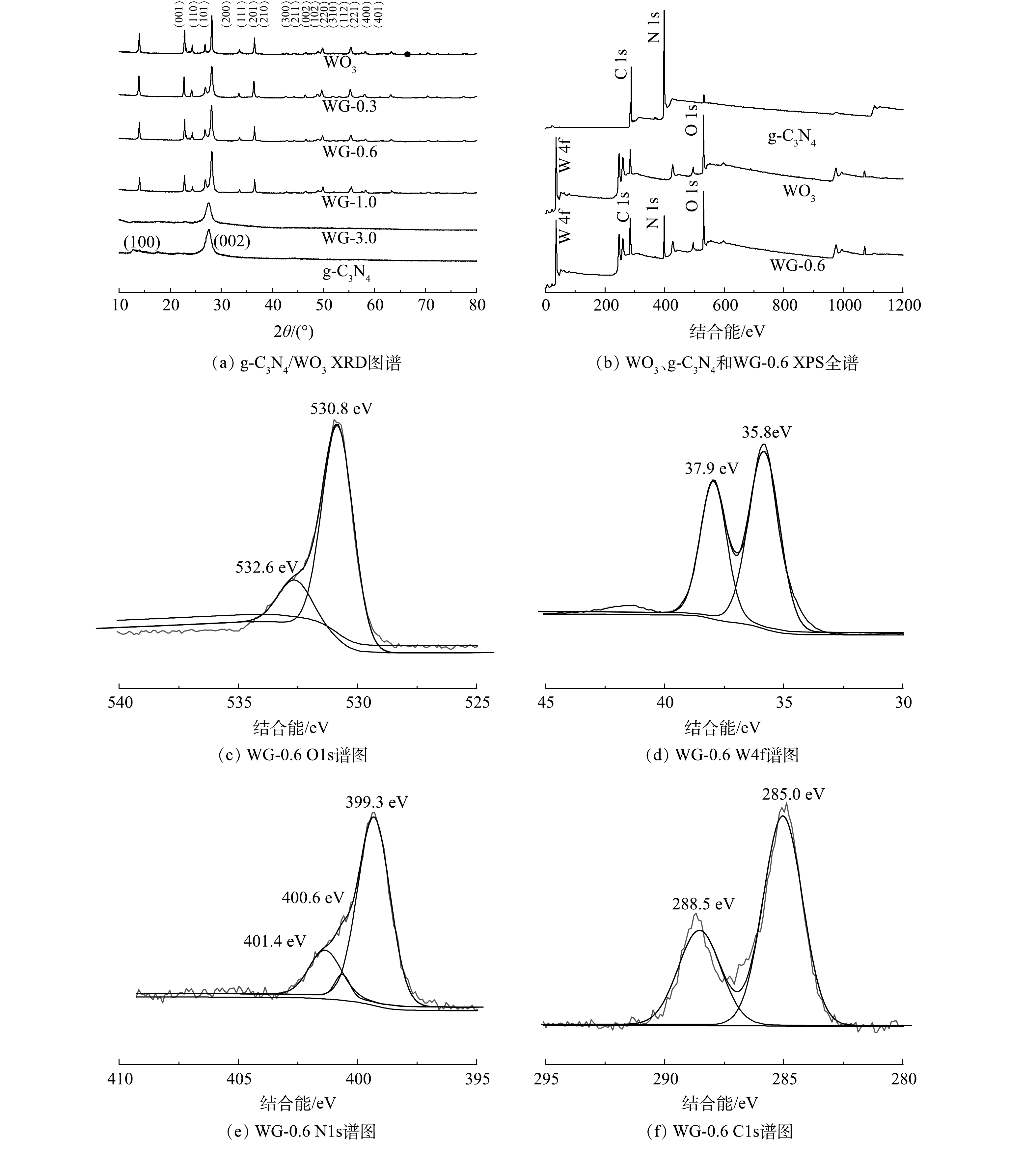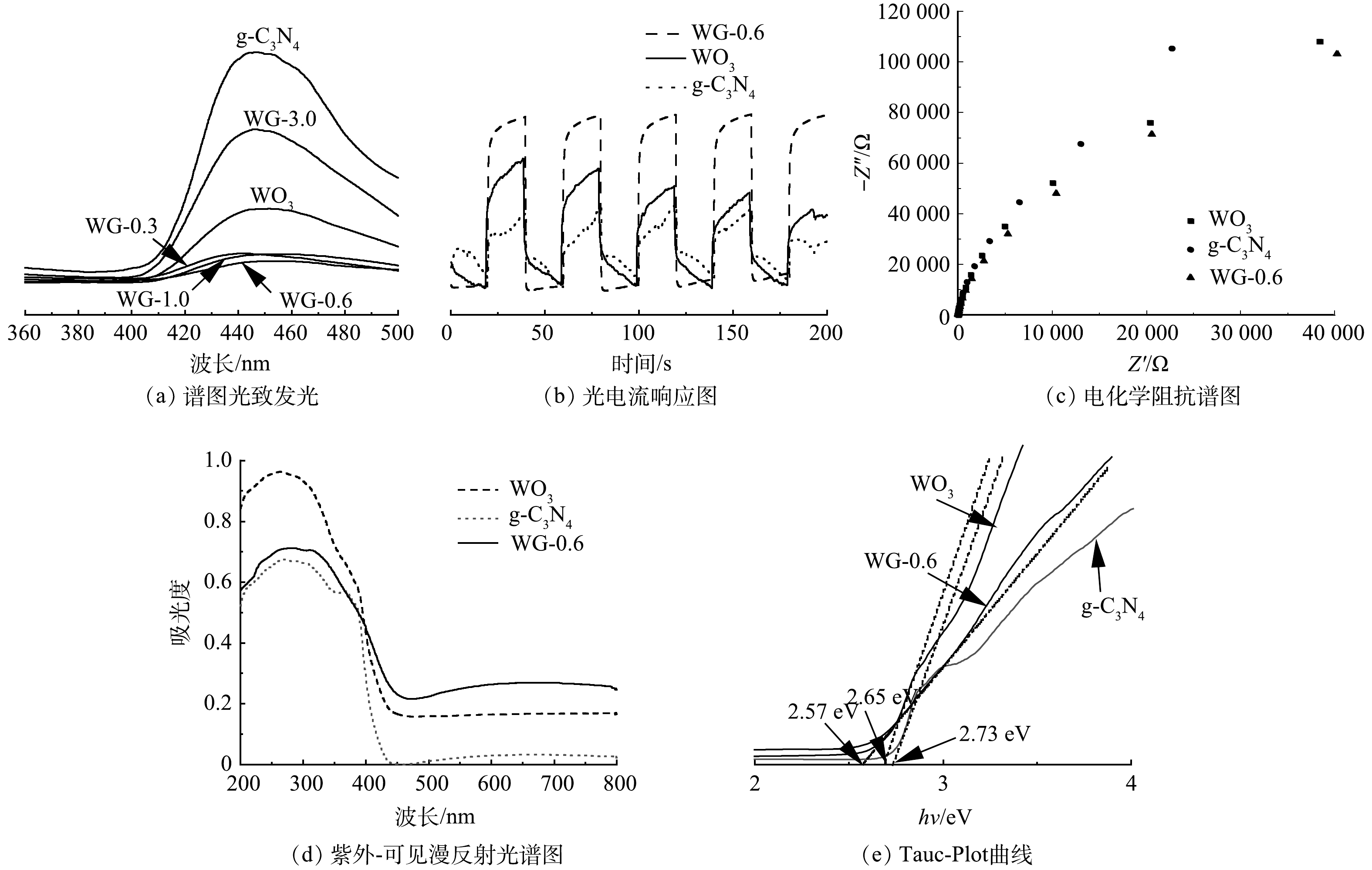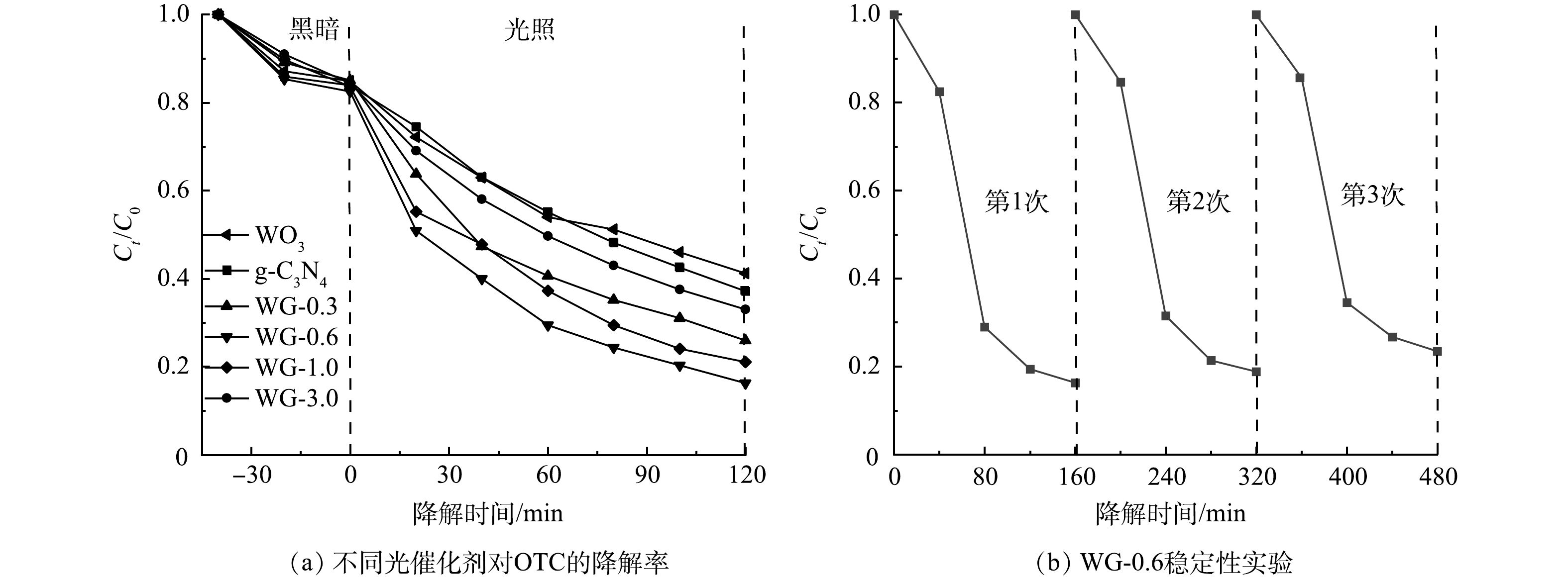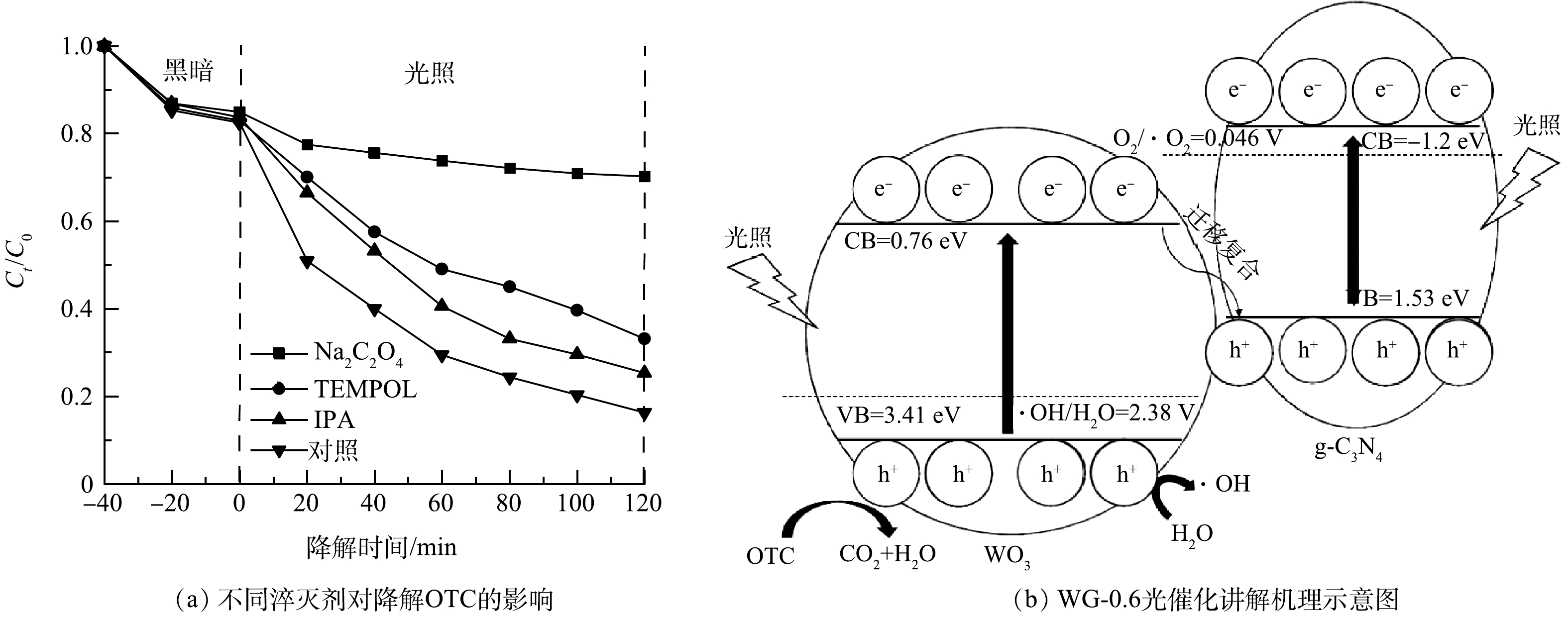-
抗生素是一种具有抗菌活性的药物[1],可以用于预防和治疗微生物引起的多种疾病[2]。近年来,滥用抗生素带来的生态环境问题已经成为全球性热点关注问题。水环境中残留抗生素的污染分布范围广,具有毒性大、浓度低、难降解、易生物富集等特性[3]。目前降解抗生素的常用方法有物理吸附[4]、化学氧化[5]和生物降解[6]等。其中光催化氧化技术由于有效性、低成本、高稳定性和环境友好性被广泛用于降解抗生素废水[7]。
三氧化钨(WO3)是n型纳米结构半导体,其禁带宽度约为2.6~2.8 eV,制备成本低、绿色环保、具有优异化学稳定性和良好的光催化性能[8-11],因此,被认为是一种有潜力代替TiO2的光催化材料。但由于光生电子和空穴复合率高,其在光催化领域的应用受到了限制,有研究指出构建Z型异质结结构有助于提高WO3的光催化活性[12-15]。
近年来,高分子石墨氮化碳(g-C3N4)被报道为一种新型的无金属光催化剂,其具有2.7 eV的可见光响应窄带隙[16]。g-C3N4制备简单、具有优异的吸附性能和稳定的化学性质,常被用作载体材料。苏跃涵等[17]制备出二维超薄g-C3N4,提高了光催化过程对于恩诺沙星的降解。YU等[18]使用微波加热法制备出金字塔状g-C3N4阵列,其具有较大的比表面积,光生载流子分离效率高,表现出优异的光催化活性,对罗丹明B的脱色率高达99.5%。有研究表明,g-C3N4/WO3异质结材料具有良好的光催化性能[19-20],采用球磨法合成的g-C3N4/WO3具有较高的比表面积,导致光生载流子在可见光下分离和迁移增强,且对罗丹明B的光催化活性明显增强。然而目前将g-C3N4与WO3进行复合并用于降解四环素类抗生素的研究较少,对于g-C3N4/WO3光催化降解抗生素机理的研究较欠缺。
本研究通过原位水热法制备出g-C3N4/WO3复合光催化材料。分析了不同g-C3N4含量的g-C3N4/WO3复合材料的形貌结构和光电性能,并评价了其对土霉素溶液的光催化降解性能和稳定性。最后通过自由基淬灭实验探寻g-C3N4/WO3光催化降解机理。本研究制备的具有高效光生载流子分离、优异氧化还原能力和高吸附能力的Z型异质结光催化剂,对抗生素的去除具有一定的应用价值,可为光催化氧化技术处理抗生素废水提供参考。
-
首先采用热缩聚法合成层状g-C3N4。将装有尿素的氧化铝坩埚放入马弗炉中550 ℃下煅烧4 h,自然冷却至室温后收集黄色固体,用蒸馏水和乙醇洗涤3次后在60 ℃下烘干研磨备用。
以二水钨酸钠化合物作为前驱体通过水热反应制备g-C3N4/WO3复合材料。先称取3.30 g Na2WO4·2H2O和一定量的NaCl结构导向剂溶解于40 mL去离子水中,均匀揽拌20 min至原料完全溶解,再加入不同质量(0.3、0.6、1.0、3.0 g)的g-C3N4,搅拌均匀。随后,向溶液中缓慢滴入3 mmol·L−1盐酸溶液同时不断搅拌以调节体系pH至2.0,形成有黄色沉淀的悬浮液。持续揽拌1 h后转移到容量为100 mL的不锈钢高压反应釜中密封并在160 ℃的烘箱中加热24 h。自然冷却至室温后将固体产物进行离心,用蒸馏水和乙醇洗涤3次,最后在60 ℃下烘干(根据g-C3N4不同的添加量,分别将样品命名为WG-0.3、WG-0.6、WG-1.0、WG-3.0,其中W代表WO3,G代表g-C3N4,数字代表复合材料中g-C3N4的添加量分别为0.3、0.6、1.0、3.0 g)。
-
采用PANalytical公司的PW3040/60型X射线衍射仪XRD对复合材料进行晶体结构分析;使用ESCLAB250型X射线光电子能谱仪XPS分析复合材料的表面化学组成,不同元素的XPS谱图以C1s结合能284.8 eV为基准进行校正;采用JEOL公司的JSM-7001F型发射扫描电子显微镜SEM,获取复合材料的微观形貌特征和尺寸。
采用日立公司F-4500型荧光分光光度计测得复合材料的光致发光谱图,观察光催化剂被光激发后电子空穴对的复合状态。复合材料的光电化学性能通过电化学工作站在三电极系统中进行测试,包括瞬态光电流和电化学阻抗谱EIS,用于评估载流子的分离和迁移效率。其中,复合材料作为工作电极,Pt电极作为对电极,饱和甘汞电极作为参比电极,电解质溶液为0.5 mol·L−1硫酸钠溶液。工作电极通过如下方法制备:称取10 mg粉末样品分散在1 mL超纯水溶液中,再加入50 uL Nafion乙醇溶液,超声30 min形成悬浮液,然后在ITO玻璃上滴加150 uL悬浮液,室温下晾干进行光电测试。光电测试所用的光源为北京泊菲莱公司所生产的300 W氙灯(型号PLS-SXE300C)。在EIS测试时,电场变化频率围0.1 Hz~100 kHz,电解质溶液为0.5 mol·L−1硫酸钠溶液。采用安捷伦公司CARY300/PE lambda 750S型光谱仪测得复合材料的紫外-可见漫反射光谱UV-Vi并确定光响应范围及吸收强度。
-
实验采用420 nm滤波片滤除小波长光,300 W氙灯作为光源。每组实验加入50 mg复合材料至含有100 mL 20 mg·L−1 OTC溶液的反应器中。先将混合溶液在黑暗条件下搅拌40 min,使OTC在样品上达到吸附平衡。然后开始光照,每隔20 min取样5 mL,经高速离心除去沉淀,取上清液用于测定HitachiU-3500紫外-可见分光光度计在360 nm处的吸光度值,测定OTC浓度。
实际工程应用中,光催化剂的稳定性至关重要,通过将反应后的复合材料对20 mg·L−1 OTC溶液进行光催化降解的重复实验测试其稳定性。每完成1组循环实验后,将复合材料离心、洗涤、过滤和干燥后用于下1组实验。循环实验次数为3次。
-
在光催化降解OTC的过程添加草酸钠(Na2C2O4,10 mmol·L−1)、异丙醇(IPA,10 mmol·L−1)和超氧化物淬灭剂(TEMPOL,10 mmol·L−1),分别作为空穴(h+)、羟基自由基(·OH)和超氧自由基(·O2−)的淬灭剂。将3种淬灭剂分别加入到含有50 mg WG-0.6的100 mL的OTC溶液中,在黑暗条件下持续搅拌40 min,使OTC在样品上达到吸附平衡。开始光照后,每隔20 min取样5 mL经高速离心除去沉淀,取上清液使用HitachU-3500紫外-可见分光光度计测定在360 nm处的吸光度值。
-
XRD被用于表征复合材料的晶体结构,如图1(a)所示,g-C3N4存在由层面结构堆积而形成的位于27.41的(002)晶面,而块体g-C3N4具有的来自芳香体系的特征晶面间堆积的(100)晶面非常微弱,表明g-C3N4已成功分层剥离。对于具有不同g-C3N4量的g-C3N4/WO3复合材料,观察到所有复合材料的WO3的特征衍射峰,与标准粉末衍射卡(JCPDS)no.35-1001相一致,均为六方相WO3[21]。g-C3N4的(002)衍射峰位置与WO3(101)(200)晶面的衍射峰位置接近,因此,不同g-C3N4含量的g-C3N4/WO3复合材料的主要特征衍射峰与原始WO3的特征衍射峰相近。随着g-C3N4质量含量的增加,WO3的相对衍射峰强度逐渐减弱。此外,当g-C3N4的投加量达到3.0 g时,WO3的衍射图样没有被探测到,表明WO3已经被g-C3N4完全覆盖,同时g-C3N4的(001)晶面的衍射峰也消失。以上结果表明层状g-C3N4与WO3纳米粒子成功地复合。
为深入了解g-C3N4、WO3和WG-0.6复合材料表面元素的化学状态,进行XPS测试。XPS全谱图显示WG-0.6复合材料中存在氧、钨、氮和碳元素。O1s、W4f、N1s和C1s的高分辨率光谱如图1(b)所示。对于图1(c)中的O1s,该峰可分解成530.8 eV和532.6 eV的2个峰,分别对应于W-O-W和W-O-H的氧结合物种。如图1(d)所示,在W4f图谱中结合能分别位于35.8 eV和37.9 eV的W4f7/2和W4f5/2峰,表明WG-0.6中的W为W6+的特征。在N1s光谱中,在401.4、400.6和399.3 eV处可识别出3个峰,分别对应C-N-H,N-(C)3和sp2杂化氮(C=N-C),从而证实sp2键石墨氮化碳的存在,如图1(e)所示。如图1(f)所示,C1s的高分辨率光谱可分为2个峰值,分别为285.0 eV对应sp2C-C键和288.5 eV对应含氮芳环中sp2键的碳(N-C=N)[22]。
使用扫描电镜SEM对光催化剂的结构及形貌分析。由图2(a)可见,WO3为大量纳米棒团聚形成的均匀三维花状微球,其单体为长约500~800 nm,直径约为30 nm的纳米棒。由图2(b)可见,g-C3N4则是通过g-C3N4纳米片的聚集而构建的,结构纹理清晰,表现出典型的带褶皱层状结构。由图2(c)可见,较小的WO3纳米棒修饰在大颗粒层状g-C3N4上,分散性及形貌特征与花状微球形的WO3明显不同。可以观察到,其表面没有表现出明显的g-C3N4层状结构,这意味着g-C3N4纳米片被WO3纳米棒均匀覆盖。纳米棒覆盖在纳米片上的堆积结构增加了材料比表面积,从而可提高其对OTC的吸附能力,促进光催化剂与污染物的接触,有利于提高对OTC的降解率。
-
测试WO3、g-C3N4和g-C3N4/WO3复合材料的光致发光谱图,结果如图3(a)所示,以确定光生载流子分离的效率。g-C3N4的光致发光光谱在450 nm附近有一强发射峰,这可能与g-C3N4的光生电子和空穴的复合有关。g-C3N4/WO3复合材料的光致发光强度明显低于g-C3N4,g-C3N4/WO3复合材料中光生电子和空穴的复合受到极大的抑制,而WG-0.6的光致发光强度最低,表明适当的g-C3N4/WO3复合比例可形成更有效的光生载流子分离路径。
为了进一步研究g-C3N4/WO3复合材料的异质结对光生电子和空穴分离效率的影响,测试了g-C3N4、WO3和WG-0.6可见光照射下的瞬态光响应电流,如图3(b)所示。在4个关灯周期过程中的光电流密度与照射时间关系曲线。当灯关闭时,光电流密度接近于零,当灯打开时,光电流密度迅速增加并稳定在一定值。结果显示,WG-0.6表现出较强的光电流密度,表明其具有较高的光生载流子分离率,有利于提高其对可见光的活性。
g-C3N4、WO3和WG-0.6的电化学阻抗谱(EIS)也验证了光电流测试结果。电化学阻抗测试中Nyquist曲线中半圆的直径与电荷迁移电阻有关,Nyquist曲线半圆直径越小说明电子迁移阻力越小[23]。图3(c)为g-C3N4、WO3和WG-0.6的电化学阻抗谱图。相比其他2种材料,WG-0.6的圆弧半径更小,表明电子转移阻力更低,光生载流子的分离更迅速。
紫外-可见漫反射光谱显示,g-C3N4、WO3和g-C3N4/WO3复合材料均在可见光区有典型的半导体吸收。如图3(d)所示,在450 nm附近观察到WO3的吸收边缘,与其他学者研究一致[24]。g-C3N4在约430 nm处显示出吸收边缘。相比于g-C3N4与WO3,WG-0.6在可见光区域表现出较高的吸收强度,且吸收边带有明显的红移。由此可见,通过在WO3上负载g-C3N4改变了原材料的能带结构,从而可增强其对可见光的吸收响应。
根据Tauc-Plot曲线,如图3(e)所示估算光催化剂的带隙,得到g-C3N4、WO3和WG-0.6的带隙分别为2.73、2.65和2.57 eV。综上所述,g-C3N4和WO3构建的Z型异质结结构有利于促进光生载流子的分离。
-
通过光催化降解土霉素实验来研究不同光催化材料的活性。如图4(a)所示,暗反应阶段显示各光催化材料都具有较好的吸附能力。当g-C3N4的添加量为0.6 g时,g-C3N4/WO3复合材料的光催化活性最好。随着g-C3N4添加量从0增加到0.6 g,g-C3N4/WO3的光催化活性增强。当g-C3N4含量超过0.6 g时,g-C3N4/WO3的光催化活性下降。结果表明,g-C3N4的含量对于g-C3N4/WO3复合材料的活性有很大影响,其中g-C3N4的最佳添加量为0.6 g。当g-C3N4的添加量高于0.6 g时,WO3的量不足以在g-C3N4和WO3之间构建有效的异质结来分离和转移光生电子空穴对。当g-C3N4的含量过小时,WO3的含量过高导致复合材料的WO3壳变厚,外层的WO3远离g-C3N4,电荷分离会更低效,光生电子和空穴在移动过程中更容易复合,会降低光催化降解率。
为评价g-C3N4/WO3复合光催化剂的稳定性和重复使用性,在相同条件下用WG-0.6光催化降解OTC 3次,结果如图4(b)所示。OTC经3次光催化降解循环后,WG-0.6的光催化性能略有下降。3次循环实验后,OTC的光催化降解率在120 min内达到77%,表明g-C3N4/WO3复合材料具有良好的光催化稳定性。活性减弱的主要原因是催化剂在循环过程中有所损失。
-
为研究WG-0.6光催化氧化过程中的主要活性物种,进行自由基淬灭实验。如图5(a)所示,光照120 min后,空白对照组和加入Na2C2O4(h+淬灭剂)、TEMPOL(·O2−淬灭剂)、IPA(·OH淬灭剂)后对OTC的光降解率分别为86%、30.2%、66.9%、74.7%,说明h+、·O2−和·OH共同参与g-C3N4/WO3光催化降解OTC反应。其中加入Na2C2O4光催化降解率下降高达55.8%,说明h+在g-C3N4/WO3光催化降解OTC中起主要作用。半导体的导带位置EVB和价带位置ECB可根据经验式(1)~(2)计算[25]。
式中:X、Ee和Eg分别表示半导体的绝对电负性、自由能和带隙能量。WO3和g-C3N4的X分别为6.59 eV和4.67 eV。Ee大约为4.5 eV,WO3和g-C3N4的Eg分别为2.65 eV和2.73 eV。因此,WO3和g-C3N4的EVB计算分别为3.41 eV和1.53 eV,ECB计算分别为0.76 eV和−1.2 eV。如图5(b)所示,在可见光照射下,g-C3N4和WO3产生光生电子空穴对。因为g-C3N4的ECB比E0(O2/·O2−)=0.046 V更低,g-C3N4导带上的电子可以将溶解的O2还原成·O2−。因为WO3的EVB比E0(·OH/H2O)=2.38 V更高,WO3价带上的空穴可以与水反应生成·OH。WO3导带上的电子开始迁移并与g-C3N4的价带上的空穴复合。最后,OTC在h+、·O2−和·OH的共同作用下被降解。
-
1)通过原位一步水热法成功合成了g-C3N4/WO3异质结材料。WO3纳米棒均匀地负载在层状的g-C3N4上,形成g-C3N4/WO3异质结结构,光生电子和空穴复合率降低,光吸收范围和吸收强度增强。
2) WG-0.6在可见光照射120 min后OTC降解率高达86%,并且在循环使用3次后仍具有较好催化活性,表现出较高的稳定性。
3) h+、·O2−和·OH共同参与g-C3N4/WO3光催化降解OTC反应,其中h+起主要作用。
Z型g-C3N4/WO3复合材料光催化降解土霉素
Photocatalytic degradation of oxytetracycline by Z-scheme g-C3N4/WO3 composite
-
摘要: 采用原位水热法,将WO3纳米棒负载在层状的g-C3N4上制备具有高吸附性和光催化活性的Z型g-C3N4/WO3复合光催化剂。通过XRD、XPS和SEM对复合材料的形貌和结构进行了表征,并测试其光致发光光谱、光电流和紫外可见漫反射光谱;考察了在可见光下g-C3N4/WO3复合材料对土霉素的降解效果及复合材料的可重复利用性能,并结合自由基淬灭实验初步推测了g-C3N4/WO3的光催化机理。结果表明,WO3纳米棒负载到g-C3N4纳米片上并形成异质结;g-C3N4/WO3异质结增强了可见光响应且降低了光生载流子复合率;添加0.6 g g-C3N4的g-C3N4/WO3复合光催化剂具有最佳的光催化活性,在可见光照射下120 min对土霉素的降解率达到86%,优于单组分的g-C3N4和WO3,且稳定性较好;在g-C3N4/WO3降解土霉素过程中,空穴(h+)为主要活性物质。
-
关键词:
- g-C3N4/WO3 /
- 可见光 /
- 光催化降解 /
- Z型异质结 /
- 土霉素
Abstract: The Z-scheme g-C3N4/WO3 composite photocatalyst with high adsorption and photocatalytic activities was prepared by in-situ hydrothermal method by loading WO3 nanorods onto layered g-C3N4. The structure and morphology were characterized by XRD, XPS and SEM. Photoluminescence spectroscopy, photocurrents and UV-Vis diffuse reflection spectroscopy were also tested. The degradation effect of oxytetracycline (OTC) by g-C3N4/WO3 composites under visible light and their reusability were investigated, and the photocatalytic mechanism of g-C3N4/WO3 was preliminarily speculated with free radical quenching experiments. The results showed that heterojunctions were formed after WO3 nanorods loading on g-C3N4 nanosheets. The g-C3N4/WO3 heterojunction enhanced the visible light response and reduced the photogenerated carrier complexation rate. The g-C3N4/WO3 composite photocatalyst with 0.6 g g-C3N4 had the best photocatalytic activity, and the degradation rate of OTC reached 86% after 120 min visible light irradiation, which was superior to that of the single-component g-C3N4 or WO3, and the stability was better. In OTC degradation by g-C3N4/WO3, the holes (h+) were the main active substances.-
Key words:
- g-C3N4/WO3 /
- visible light /
- photocatalytic degradation /
- Z-scheme heterojunction /
- OTC
-

-
-
[1] 刘宏, 庞族族, 石林, 等. 光催化降解喹诺酮类抗生素的研究进展[EB/OL]. [2022-12-20].工业水处理, 1-4. https://kns.cnki.net/kcms/detail/12.1087.TQ.20220927.1504.001.html. [2] 杜玉海, 王晓云, 范增博, 等. rGO/MoS2-CN的制备及可见光催化降解磺胺类抗生素的性能研究[J]. 环境化学, 2022, 41(9): 3012-3021. [3] 廖洋, 鲁金凤, 曹轶群, 等. 光催化降解对抗生素藻类毒性效应影响研究进展[J]. 环境化学, 2021, 40(1): 111-120. [4] 阳春, 王瀚, 王琦, 等. 氨基改性磁性介孔硅对磺胺类抗生素的吸附研究[J]. 中国给水排水, 2022, 38(23): 123-128. [5] 刘路明, 高志敏, 邓兆雄, 等. 过硫酸盐的活化及其在氧化降解水中抗生素的机理和应用[J]. 环境化学, 2022, 41(5): 1702-1717. [6] 段彤, 曾小芸, 谈树成. MBR处理猪场废水过程中抗生素抗性基因的去除[J]. 环境工程, 2022, 40(4): 8-13. [7] 张帆, 刘晓娜, 李博, 等. 模拟日光下铌酸盐/钛酸纳米片催化降解水中环丙沙星[J]. 环境工程学报, 2022, 16(10): 3232-3242. [8] 杨天翔, 王银号, 张永伟, 等. 氧化钨纳米棒团簇的制备及电催化性能[J]. 无机化学学报, 2023, 39(2): 221-233. [9] 吴亮. CuWO4/WO3的制备及其对含油污泥的光催化氧化处理[J]. 化工环保, 2023, 43(1): 107-112. [10] 李厚芬, 薛帅, 曹雅洁, 等. 类单晶纳米片状WO3的制备及其光催化性能[J]. 中国环境科学, 2021, 41(4): 1615-1623. [11] 陈宝宁, 丁春华, 方岩雄, 等. Ag2O/WO3-SiO2气凝胶的制备及光催化性能研究[J]. 工业水处理, 2022, 43(2): 136-141. [12] LIU X, JIN A, JIA Y, et al. Synergy of adsorption and visible-light photocatalytic degradation of methylene blue by a bifunctional Z-scheme heterojunction of WO3/g-C3N4[J]. Applied Surface Science, 2017, 405: 359-371. doi: 10.1016/j.apsusc.2017.02.025 [13] LING Y, DAI Y. Direct Z-scheme hierarchical WO3/BiOBr with enhanced photocatalytic degradation performance under visible light[J]. Applied Surface Science, 2020, 509: 145201. [14] LI P, GUO J, JI X, et al. Construction of direct Z-scheme photocatalyst by the interfacial interaction of WO(3) and SiC to enhance the redox activity of electrons and holes[J]. Chemosphere, 2021, 282: 130866. [15] ASLAM I, CAO C, TANVEER M, et al. A novel Z-scheme WO3/CdWO4 photocatalyst with enhanced visible-light photocatalytic activity for the degradation of organic pollutants[J]. RSC Advances, 2015, 5(8): 6019-6026. doi: 10.1039/C4RA15847D [16] GHOSH U, PAL A. Graphitic carbon nitride based Z scheme photocatalysts: Design considerations, synthesis, characterization and applications[J]. Journal of Industrial and Engineering Chemistry, 2019, 79: 383-408. doi: 10.1016/j.jiec.2019.07.014 [17] 苏跃涵, 王盈霏, 张钱新, 等. 二维超薄g-C3N4的制备及其光催化性能研究[J]. 中国环境科学, 2017, 37(10): 3748-3757. [18] YU Y, WANG C, LUO L, et al. An environment-friendly route to synthesize pyramid-like g-C3N4 arrays for efficient degradation of rhodamine B under visible-light irradiation[J]. Chemical Engineering Journal, 2018, 334: 1869-1877. doi: 10.1016/j.cej.2017.11.133 [19] ZHAO Q, LIU S, CHEN S, et al. Facile ball-milling synthesis of WO3/g-C3N4 heterojunction for photocatalytic degradation of Rhodamine B[J]. Chemical Physics Letters, 2022, 805:139908. [20] DU J, WANG Z, LI Y, et al. Establishing WO3/g-C3N4 composite for “memory” photocatalytic activity and enhancement in photocatalytic degradation[J]. Catalysis Letters, 2019, 149(5): 1167-1173. doi: 10.1007/s10562-019-02711-z [21] ZHENG F, ZHANG M, GUO M. Controllable preparation of WO3 nanorod arrays by hydrothermal method[J]. Thin Solid Films, 2013, 534: 45-53. doi: 10.1016/j.tsf.2013.01.102 [22] HAN X, XU D, AN L, et al. WO3/g-C3N4 two-dimensional composites for visible-light driven photocatalytic hydrogen production[J]. International Journal of Hydrogen Energy, 2018, 43(10): 4845-4855. doi: 10.1016/j.ijhydene.2018.01.117 [23] GRIGIONI I, CORTI A, DOZZI M V, et al. Photoactivity and stability of WO3/BiVO4 photoanodes: Effects of the contact electrolyte and of Ni/Fe oxyhydroxide protection[J]. The Journal of Physical Chemistry C, 2018, 122(25): 13969-13978. doi: 10.1021/acs.jpcc.8b01112 [24] SUN M, ZHOU Y, YU T, et al. Synthesis of g-C3N4/WO3-carbon microsphere composites for photocatalytic hydrogen production[J]. International Journal of Hydrogen Energy, 2022, 47(18): 10261-10276. doi: 10.1016/j.ijhydene.2022.01.103 [25] 杨利伟, 刘丽君, 夏训峰, 等. pg-C3N4/BiOBr/Ag复合材料的制备及其光催化降解磺胺甲(口恶)唑[J]. 环境科学, 2021, 42(6): 2896-2907. -




 下载:
下载:





